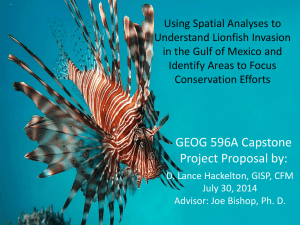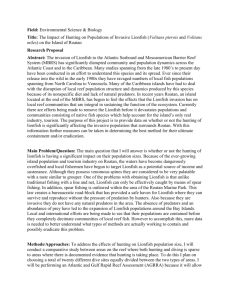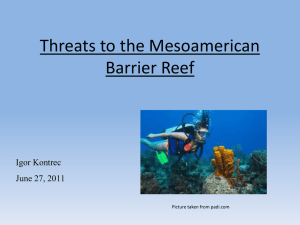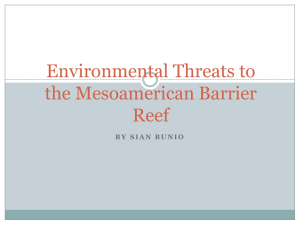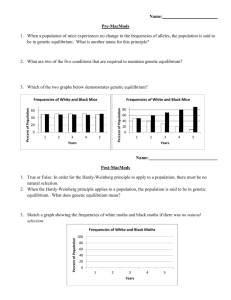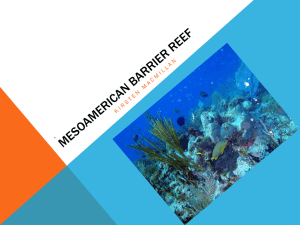CWG_Review1_N-6 - Our Florida Reefs
advertisement
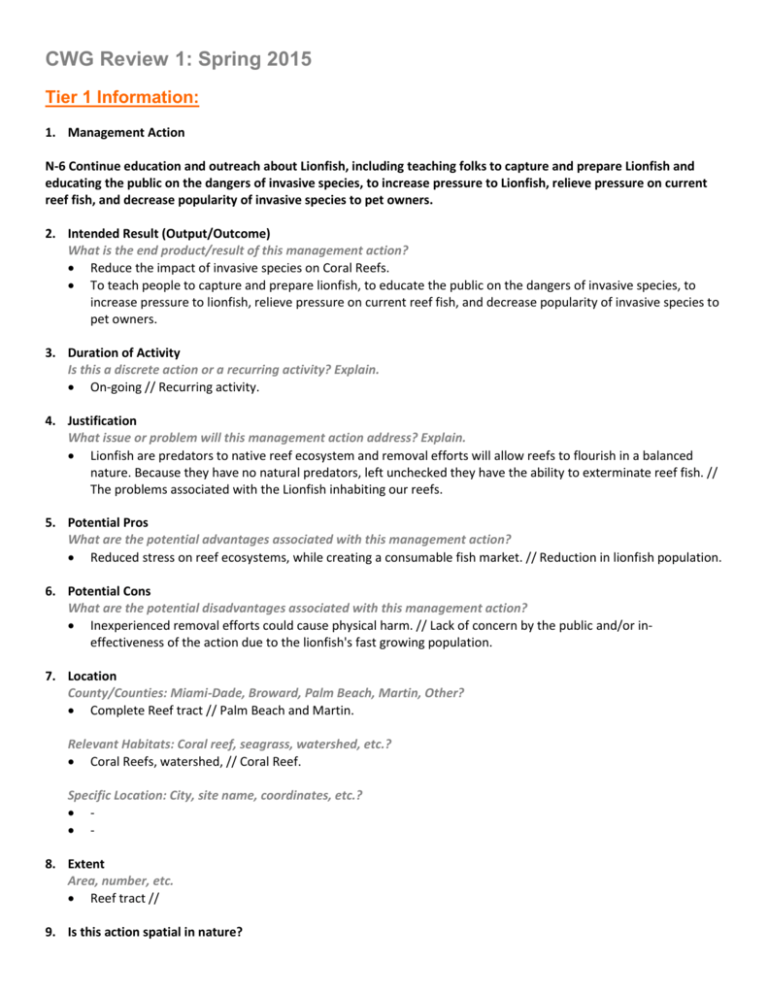
CWG Review 1: Spring 2015 Tier 1 Information: 1. Management Action N-6 Continue education and outreach about Lionfish, including teaching folks to capture and prepare Lionfish and educating the public on the dangers of invasive species, to increase pressure to Lionfish, relieve pressure on current reef fish, and decrease popularity of invasive species to pet owners. 2. Intended Result (Output/Outcome) What is the end product/result of this management action? Reduce the impact of invasive species on Coral Reefs. To teach people to capture and prepare lionfish, to educate the public on the dangers of invasive species, to increase pressure to lionfish, relieve pressure on current reef fish, and decrease popularity of invasive species to pet owners. 3. Duration of Activity Is this a discrete action or a recurring activity? Explain. On-going // Recurring activity. 4. Justification What issue or problem will this management action address? Explain. Lionfish are predators to native reef ecosystem and removal efforts will allow reefs to flourish in a balanced nature. Because they have no natural predators, left unchecked they have the ability to exterminate reef fish. // The problems associated with the Lionfish inhabiting our reefs. 5. Potential Pros What are the potential advantages associated with this management action? Reduced stress on reef ecosystems, while creating a consumable fish market. // Reduction in lionfish population. 6. Potential Cons What are the potential disadvantages associated with this management action? Inexperienced removal efforts could cause physical harm. // Lack of concern by the public and/or ineffectiveness of the action due to the lionfish's fast growing population. 7. Location County/Counties: Miami-Dade, Broward, Palm Beach, Martin, Other? Complete Reef tract // Palm Beach and Martin. Relevant Habitats: Coral reef, seagrass, watershed, etc.? Coral Reefs, watershed, // Coral Reef. Specific Location: City, site name, coordinates, etc.? 8. Extent Area, number, etc. Reef tract // 9. Is this action spatial in nature? Yes Do you believe this management action could be informed by the Our Florida Reefs Marine Planner Decision Support Tool? If yes, you will proceed to the next section on Marine Planner Information. Yes Marine Planer Information: N/A Tier 2 Information: WHY? 1. Strategic Goals & Objectives to be Achieved Refer to the SEFCRI Coral Reef Management Goals and Objectives Reference Guide. FDEP CRCP Education and Outreach Goal A, B, and C FDEP CRCP Coral Reef Ecosystem Conservation Goal A, and D KF/AP 2. Current Status Is this activity currently underway, or are there planned actions related to this recommendation in southeast Florida? If so, what are they, and what is their status. Currently there are numerous lionfish education and outreach efforts going on both local and state levels. These efforts need to continue to occur to stay on top of the invasion. 3. Intended Benefits (Outcomes) What potential environmental benefi.ts or positive impacts might this management action have? Increases the number of extractions of lionfish from the reefs and estuaries with the intent of providing undue pressure of all other habitats What potential social/economic benefits or positive impacts might this management action have? Increase diver participation, increased market for lionfish What is the likely duration of these benefits - short term or long-lasting? Explain. Studies have shown that eradication will only last up to a year but this will need to be an on-going effort. 4. Indirect Costs (Outcomes) What potential negative environmental impacts might this action have? Possible reef damage from uneducated , unskilled users. What potential negative social/economic impacts might this action have? N/A What is the likely duration of these negative impacts - short term or long-lasting? Explain. Short-term, proper removal will be a key part of the education outreach. 5. Risk What is the threat of adverse environmental, social, or economic effects arising from not implementing this action? Environmental: Lionfish will continue to diminish reef ecosystems, Economic: Lionfish will decrease the availability of catch of native species leaving less for fishing and diving efforts. Social: less reasons for people to fish and dive the coral reef tract and more imported fish for table fare. 6. Relevant Supporting Data What existing science supports this recommendation? (Provide citations) http://www.mclionfish.com/research-projects.html 7. Information Gaps What uncertainties or information gaps still exist? More comprehensive population study, areas that need to be targeted. Ways to target fish at deeper depths. Will a predator of the lionfish come about? What is the long term effect of lionfish on the fishery? WHEN? 8. Anticipated Timeframe for Implementation How long will this recommendation take to implement? 0 - 2 years 9. Linkage to Other Proposed Management Actions Is this activity linked to other proposed management recommendations? Yes If so, which ones, and how are they linked? (e.g., is this activity a necessary step for other management actions to be completed?) N-2,N-4,N-5,N-9,N-10,N-11,N-12,N-14,N-15,N-18,N-20,N-21, N-23,N-31,N-32,N-34,N 35,N-43,N-51,N-58. They are linked by multiple reef action plans and deal with public outreach Does this activity conflict with other existing or proposed management actions? - WHO? 10. Lead Agency or Organization for Implementation What agency or organization currently has/would have authority? Refer to the Agencies and Actions Reference Guide. Florida Fish and Wildlife Conservation Commission 11. Other Agencies or Organizations Are there any other agencies or organizations that may also support implementation? Explain. Local Governments, NGO's, NOAA, FDEP Rec and Parks, NMFS, National Park Service, Marine Indistries They are all involved in public education with resources within their jurisdiction. 12. Key Stakeholders Identify those stakeholders most greatly impacted by this management action, including those from whom you might expect a high level of support or opposition. Explain. Divers, Fisherman (to include recreational and commercial) HOW? 13. Feasibility Is there appropriate political will to support this? Explain. Yes, it is evident that this species got out of control quickly and putting undue pressure on our reef ecosystem. What are the potential technical challenges to implementing this action? Has it been done elsewhere? Funding needed to continue to enhance outreach. 14. Legislative Considerations Does the recommendation conflict with or actively support existing local, state, or federal laws or regulations? Explain. N/A 15. Permitting Requirements Will any permits be required to implement this action? Explain. N/A 16. Estimated Direct Costs Approximately how much will this action likely cost? (Consider one-time direct costs, annual costs, and staff time, including enforcement.) $50,000 - $100,000 Will costs associated with this activity be one-time or recurring? This will be an annual recurring cost. If recurring, approximately how long will staff time and annual costs be necessary to implement the management action? Years 17. Enforcement Does this require enforcement effort? No Provide an explanation if available. 18. Potential Funding Sources Identify potential funding organizations/grant opportunities, etc. Private business grants, recreational fishing license fees, vessel registration fees. 19. Measurable Outcomes/Success Criteria/Milestones How will the success of this recommendation be measured? How will you know when the intended result is achieved? Increased participation (demographic) in Lionfish events, seeing more hits on lionfish websites, brochures handed out, increased media coverage, increased sales of lionfish in the commercial market. SEFCRI/TAC Targeted Questions: 1. TAC - Is the recommendation likely to achieve the intended result? Explain. Tier 1 – #2 (Intended Result - Output/Outcome) - 2. TAC - Is the recommendation sufficient to address the identified issue or problem? Explain. Tier 1 – #4 (Justification) 3. TAC - Is the recommendation technically achievable from a science or management perspective? Explain. Tier 2 – #8 (Anticipated Timeframe for Implementation) and Tier 2 - #13 (Feasibility) 4. SEFCRI Team, PPT & Other Advisors - Has this been done (by SEFCRI, other agencies or organizations in the SEFCRI region)? Explain. Tier 2 – #2 (Current Status) JP: R.E.E.F. has had a program for a number of year involving hunts as well as PR. FWC: This is already occurring. 5. SEFCRI Team, PPT & Other Advisors - Is this recommendation a research or monitoring project? (Recommendations should be turn-dirt management actions, not the step you take before a management action). Explain. 6. SEFCRI Team, PPT & Other Advisors - If either of the following applies to this management action, provide feedback on which information submitted by the Community Working Groups may be more appropriate, or if entries should be merged. Explain. a. There are different viewpoints for an individual management action (i.e. two working group members provided separate information, as indicated by a ‘//’ marking between them). b. Information submitted for this and other draft management actions is sufficiently similar that they might be considered the same. JP: this action ties in with N58 and N136 that focus on lionfish eradication. SP: Combine N-136 and N-58 with N-6 as a subset of them. 7. SEFCRI Team, PPT & Other Advisors - Non-agency Question: Is the recommendation technically achievable from your stakeholder perspective? If not, do you have suggestions that would allow this to become technically achievable from your stakeholder perspective? Explain. Tier 1 - #5 (Potential Pros), Tier 1 - #6 (Potential Cons), Tier 2 - #3 (Intended Benefits), Tier 2 - #4 (Indirect Costs) and Tier 2 - #12 (Key Stakeholders) 8. SEFCRI Team, PPT & Other Advisors - Agency Question: Is the recommendation technically achievable from a management perspective? If not, do you have suggestions that would allow this to become technically achievable from your agency's management perspective? Explain. Tier 2 – #10 (Lead Agency or Organization for Implementation) and Tier 2 - #11 (Other Agencies or Organizations) FWC: During the 2014 legislative session, the FWC was appropriated $250,00 per year (reoccurring each year) of general revenue funding (not spending authority for existing MRCTF funds) dedicated to lionfish outreach and eduction activities. Since the FWC received the money for the first time on July 1, 2014, we have hired one full time outreach position whose duties include attending lionfish derbies and tournaments, dive club meetings, etc. and promote awareness, demonstrate safe handling and cleaning techniques, etc. We have purchased promotional items for distribution (stickers, posters, t-shirts), provided sponsorships for lionfish derbies, developed an ad campaign with Guy Harvey Magazine, developed a lionfish smartphone app that documents catches and provides educational material (like what to do if you are stung), and purchased office equipment/space, gear and display equipment required for the position. The FWC Commissioners will be designating the month of May as lionfish awareness month, and numerous events and activities will occur during that month. Visit this link for more information on FWC lionfish activities: http://myfwc.com/fishing/saltwater/recreational/lionfish/ Comments from the Reviewers: See Tier 1, Question 2: NM: This is one of 3 management actions concerning Lionfish. The others are N-136 and N-58. This one calls for continuation of existing outreach and education. Is the current program going to be discontinued or is it under threat? If not this action would seem to be unnecessary. SP: It appears that education and outreach could be a subset of N-136 and N-58. See Tier 1, Question 7: JP: estuaries almost up to freshwater as well. See Tier 2, Question 2: NM: I agree, this action does not seem to be suggesting anything new, jus a continuation of existing efforts. JP: I agree with NM. This action could be rolled in with 58 and 136. SP: Agree See Tier 2, Question 7: NM: Ways to target fish at deeper depths is an interesting question. As a tech. diver I have seen aggregations of over 100 lionfish on single wrecks in the 150 to 300 ft. depth range. SP: It is an interesting question. I know many tech divers would be interested in helping (and many already do) but have to be cautious about injury from the fish while still having to engage in long amounts of deco. ie. not being able to come directly to the surface and manage the injury. There certainly are a ton of lionfish witnessed deeper than recreational limits. See Tier 2, Question 9: JP: N-136 also. Both 136 and 58 focus on lionfish. See Tier 2, Question 11: JP: R.E.E.F. specifically has a big lionfish program. SP: REEF I think this is totally doable. Since this has become a hot topic over the past few years, groups like REEF host lionfish derbies and are doing partnerships with other groups on the West Coast to strengthen awareness. FWC now employs a lionfish outreach coordinator that goes around the state to various events for this exact purpose. Additionally, Miami-Dade county middle and high school teachers have access to Sunshine-state approved curriculum for a lionfish workshop that includes a presentation about invasive species, the history of the lionfish invasion and its potential impacts and a corresponding lionfish dissection lab. This workshop was created by Biscayne National Park and currently only serves Miami-Dade County, but could easily be adapted for the rest of the region. FDEP/AZ Questions from the Reviewers: Questions/Information Needs Highlighted by the Reviewers 1. N/A 2. Addressed by CWG: ☐ ☐ 3. ☐ Questions from the CWGs back to the Reviewers: Not Addressed by CWG Because: ☐ This does not apply. ☐ Need help addressing it. ☐ This does not apply. ☐ Need help addressing it. ☐ This does not apply. ☐ Need help addressing it.
